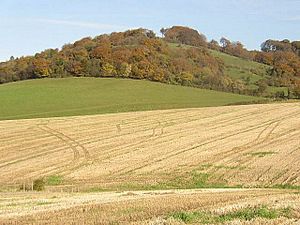Windsor Hill facts for kids
| Site of Special Scientific Interest | |
 |
|
| Area of Search | Buckinghamshire |
|---|---|
| Interest | Biological |
| Area | 61.8 hectares |
| Notification | 1984 |
| Location map | Magic Map |
Windsor Hill is a special place in Buckinghamshire, near Princes Risborough. It's a huge area, about 61.8 hectares, protected because of its amazing plants and animals. This makes it a Site of Special Scientific Interest, or SSSI for short.
It's part of the beautiful Chiltern Hills, an Area of Outstanding Natural Beauty known for its stunning natural scenery. Windsor Hill is also listed in a special review that highlights important nature spots. A small part of Windsor Hill is looked after by a group called the Berkshire, Buckinghamshire and Oxfordshire Wildlife Trust. You need a special permit to visit this particular section.
Contents
What Makes Windsor Hill Special?
Windsor Hill is mostly a large forest area on the side of the Chiltern Hills. It has different types of habitats:
This mix of habitats helps many different plants and animals to live here. It's one of only three places in Britain where you can find the rare red helleborine orchid!
The Amazing Woodlands
The woodlands at Windsor Hill are mainly made up of beech trees. These trees grow in different types of soil found on the Chiltern plateau and the chalky slopes.
- On the plateau: You'll find oak trees and sometimes birch trees growing with the beech. The ground here can have brambles, bracken, and rosebay willowherb. You might also see grasses like creeping soft-grass, hairy brome, tufted hair-grass, wood millet, and wood melick. In drier, heath-like spots, look for pill sedge, hairy wood-rush, and slender St. John's-wort. In damper areas, you might spot rushes like Juncus effusus and J. conglomeratus.
- On the slopes: Here, ash and whitebeam trees grow alongside the beech. The ground is often covered with dog's-mercury and woodruff. You might also find less common plants like nettle-leaved bellflower, different types of helleborines (like white, broad-leaved, and narrow-lipped), yellow bird's-nest, and scaly male-fern.
Scrubland and Grassland
On Windsor Hill itself, there are areas of juniper bushes. These grow with other plants that like chalky soil, and open chalk grasslands. These grasslands have lots of a moss called Pseudoscleropodium purum and common valerian. You can also find patches of bare chalk where forget-me-nots and common mullein grow.
On a nearby spot called Kop Hill, hawthorn bushes are common. The grassland here has less moss. You might discover special plants like squinancywort, chalk eyebright, horseshoe vetch, autumn gentian, and clustered bellflower. Another small area of chalk grassland is at the bottom of Pink Hill, with plants like wood false-brome and glaucous sedge.
Butterflies and Other Insects
Windsor Hill is a fantastic place for insects! Over 23 different kinds of butterflies have been seen here. One special butterfly is the brown hairstreak, which loves to live in thick bushes and along the edges of woodlands.
The juniper bushes are also home to several types of insects that only live on juniper plants. You can also find different kinds of snails here, including Abida secale, Helicella itala, and Pomatias elegans.
How to Visit
You can get to Windsor Hill from Kop Hill Road and Peters Lane. It's a great place to explore nature and see some of Britain's unique plants and animals!

